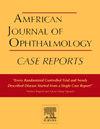健康婴儿沙门氏菌相关性眼内炎:两例报告和文献综述
Q3 Medicine
引用次数: 0
摘要
目的报告2例健康男婴沙门氏菌引起的眼内炎。背景:牙髓性眼内炎是一种罕见但严重的眼内感染,通常与糖尿病、恶性肿瘤或免疫抑制等系统性危险因素相关。然而,沙门氏菌作为一种病原体在免疫功能良好的新生儿仍然非常罕见,只有少数病例记录。我们报告了两例先前健康的男婴被诊断为沙门氏菌相关的内源性眼内炎(SAEE)。第一位患者为一名2个月大的男性,表现为发烧、左上眼睑肿胀和活动减少,并发现眼内培养证实存在沙门氏菌。尽管进行了积极的静脉和玻璃体内抗生素治疗,患者仍出现进行性眼内炎症,需要摘除左眼。第二名患者为一名5个月大的男性,表现为发烧和右眼炎症。检查发现右眼低视、前房积血和致密性玻璃体炎。血液和玻璃培养证实沙门氏菌感染,磁共振成像(MRI)显示右侧球周脓肿形成。由于药物治疗效果不佳,行右眼摘除手术。结论及重要性沙门氏菌相关性内源性眼内炎是一种罕见但侵袭性的眼内感染,可迅速发展为不可逆的视力丧失,即使在免疫功能正常的新生儿中也是如此。早期识别,积极的抗菌治疗和及时的手术干预仍然是优化结果的关键。本文章由计算机程序翻译,如有差异,请以英文原文为准。
Salmonella-associated endophthalmitis in healthy infants: Two case reports and a review of the literature
Purpose
To report two cases of endophthalmitis caused by Salmonella species in healthy male infants.
Background
Endogenous endophthalmitis is a rare but severe intraocular infection, often associated with systemic risk factors such as diabetes mellitus, malignancies, or immunosuppression. However, Salmonella species as a causative agent in immunocompetent neonates remains exceedingly rare, with only a handful of cases documented.
Observations
We present two cases of previously healthy male infants diagnosed with Salmonella-associated endogenous endophthalmitis (SAEE). The first patient, a 2-month-old male, presented with fever, left upper eyelid swelling, and decreased activity, and was found to have intraocular cultures that confirmed Salmonella species. Despite aggressive intravenous and intravitreal antibiotic therapy, the patient developed progressive intraocular inflammation, necessitating left eye evisceration.
The second patient, a 5-month-old male, presented with fever and right eye inflammation. Examination revealed a hypopyon, hyphema, and dense vitritis in the right eye. Blood and vitreous cultures confirmed Salmonella infection, and magnetic resonance imaging (MRI) showed right peribulbar abscess formation. Due to poor response to medical therapy, right eye enucleation was performed.
Conclusion and importance
Salmonella-associated endogenous endophthalmitis is a rare but aggressive intraocular infection that can rapidly progress to irreversible visual loss, even in immunocompetent neonates. Early recognition, aggressive antimicrobial therapy, and timely surgical intervention remain critical to optimizing outcomes.
求助全文
通过发布文献求助,成功后即可免费获取论文全文。
去求助
来源期刊

American Journal of Ophthalmology Case Reports
Medicine-Ophthalmology
CiteScore
2.40
自引率
0.00%
发文量
513
审稿时长
16 weeks
期刊介绍:
The American Journal of Ophthalmology Case Reports is a peer-reviewed, scientific publication that welcomes the submission of original, previously unpublished case report manuscripts directed to ophthalmologists and visual science specialists. The cases shall be challenging and stimulating but shall also be presented in an educational format to engage the readers as if they are working alongside with the caring clinician scientists to manage the patients. Submissions shall be clear, concise, and well-documented reports. Brief reports and case series submissions on specific themes are also very welcome.
 求助内容:
求助内容: 应助结果提醒方式:
应助结果提醒方式:


